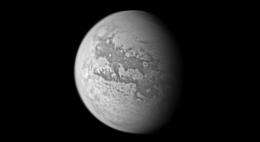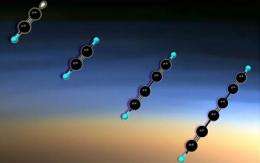Scientists unravel the chemistry of Titan's hazy atmosphere

A team of University of Hawai'i at Mānoa researchers led by Ralf Kaiser, physical chemist at UH Mānoa, unraveled the chemical evolution of the orange-brownish colored atmosphere of Saturn's moon Titan, the only solar system body besides Venus and Earth with a solid surface and thick atmosphere. The UH Mānoa team, including Xibin Gu and Seol Kim, conducted simulation experiments mimicking the chemical reactions in Titan's atmosphere utilizing crossed molecular beams in which the consequence of a single collision between molecules can be followed.
The team's experiments indicate that triacetylene can be formed by a single collision of a "radical" ethynyl molecule and a diacetylene molecule. An ethynyl radical is produced in Titan's atmosphere by the photodissociation of acetylene by ultraviolet light. Photodissociation is a process in which a chemical compound is broken down by photons.
"Surprisingly, the photochemical models show inconsistent mechanisms for the production of polyynes," said Kaiser, who is the principal investigator of this study.
The mechanism involved in the formation of triacetylene, was also confirmed by accompanying theoretical calculations by Alexander Mebel, a theoretical chemist at Florida International University. These theoretical computations also provide the 3D distribution of electrons in atoms and thus the overall energy level of a molecule. To apply these findings to the real atmosphere of Titan, Danie Liang and Yuk Yung, planetary scientists at Taiwan's Academia Sinica and California Institute of Technology, respectively, performed photochemical modeling studies of Titan's atmosphere. All data together suggest that triacetylene may serve as a building block to form more complex and longer polyynes and produce potential precursors for the aerosol-based layers of haze surrounding Titan.

The study demonstrated for the first time that a sensible combination of laboratory simulation experiments with theory and modeling studies can shed light on decade old unsolved problems crucial to understand the origin and chemical evolution of the solar system. The researchers hope to unravel next the mystery of the missing ethane lakes on Titan - postulated to exist for half a century, but not detected conclusively within the framework of the Cassini-Huygens mission.
In the future, the UH Mānoa team will combine the research results with terrestrial-based observations of Titan's atmosphere. Alan Tokunaga, astronomer at UH Mānoa's Institute for Astronomy, and Henry Roe from Lowell Observatory in Arizona, are currently collecting observational data using the NASA infrared telescope facility on the snowcapped peak of Mauna Kea.
More information: "Chemical dynamics of triacetylene formation and implications to the synthesis of polyynes in Titan's atmosphere" is published in the online early edition of Proceedings of the National Academy of Sciences at www.pnas.org/content/early/200 … /0900525106.abstract .
Source: University of Hawaii at Manoa
















